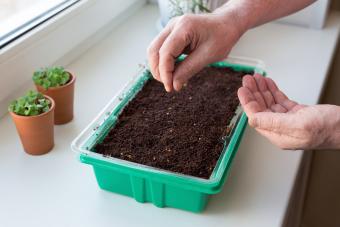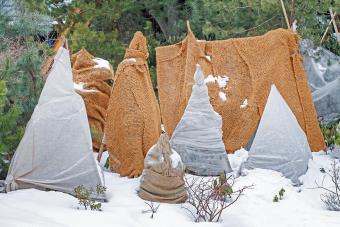
Seed germination happens when a seed sprouts so it can begin growing into a plant. All seeds need soil or another growing medium and water in order to germinate and grow. So, the most basic answer to the question of how to germinate seeds is to plant them, then water them, and let them grow.
However, as with most things related to gardening, there isn't just one way to germinate seeds. Some seeds need to be planted in the soil while others need to be sown on top of it. You can pre-soak or scarify seeds to help speed up their germination or pre-sprout them so they're already germinated before you put them in soil. Learn about the options so you can make an informed decision.
Soil-Based Seed Germination
Vegetable and flower seeds will germinate in or on soil when you water them. You should check the seed packet or look up the specific variety you're planting to find out how to plant it for proper germination.
- Surface-sowing - Seeds that need light to germinate have to be surface-sowed. Examples include dill, celery, and poppies. They need to be placed on the surface of the soil and not covered with soil. Instead, lightly press them into the dirt.
- In-ground sowing - Seeds that don't require light to germinate need to be covered with soil when planted. Examples include tomatoes, beans, and calendula. Planting depth varies by seed type and ranges from a quarter of an inch to two inches.
You can plant seeds in the spot where they will ultimately grow, or start them indoors or outdoors in seed-starting trays or small containers to transplant later to their final growing spot.
If you plant seeds outdoors when the soil is still too cold for them to germinate (which varies by seed type), they won't grow. That's why gardeners often start seeds indoors in early spring to transplant outside in late spring or summer.
Soak Seeds to Speed Up Germination
Some sources recommend soaking some seeds for a few hours - or even overnight - before planting them to help speed up germination. This isn't required, but may help seeds germinate faster than if they're planted without being soaked. Soaking before planting is most often recommended for larger seeds that have a hard coating on the outside, such as peas, beans, corn, and squash.
I don't do this for spring plantings, because having seeds germinate a few days earlier won't lead to a faster or larger harvest this time of year. I do sometimes soak seeds before succession planting in summer, as faster germination this time of year does lead to a quicker harvest.
Scarify Seeds to Speed Up Germination
Scarification is another option that some sources recommend for faster seed germination. It involves nicking the outer coating of seeds that have a hard covering, such as beans, peas, and nasturtiums. To do this, make a shallow cut into the seed's coating, being careful not to cut so deep that you damage the inner part of the seed. You can also scarify seeds by rubbing them with a nail file or sandpaper.
I don't do this. To me, the risk of damaging the seed when cutting it is too great, without enough potential reward to offset the risk. I'd rather soak them or plant them in soil. If you have extra seeds and want to speed up germination, you may want to experiment with this method. Some people combine scarification and soaking.
Germinate Seeds in Paper Towels

It's also possible to germinate seeds by spreading them out between two damp paper towels. To speed up this type of germination, you can put the towels in a plastic baggie, seal, and place it somewhere warm, such as near a sunny window. Check it after a day or so, and you may find that the seeds have sprouted. Some seeds take longer than that to sprout, so keep checking back for up to a week if necessary.
This method will sprout seeds, which is great for checking to verify that a batch of seeds will germinate or just to see what sprouted seeds look like, but it poses a challenge for planting. Sprouted seeds are delicate; if you knock off the sprouted end of a seed, it won't grow.
This method is most useful if you have some seeds that are more than a few years old and you want to make sure they're still viable before planting them. To do this, just try the paper towel planting method with a few of the seeds. If most of them sprout, then you'll know it's worthwhile to plant the rest.
Insider Tips: Learn From My Experience
Plants grow and produce when the soil and air temperature are right for their needs. I learned this firsthand - and wasted a lot of time in the process - when I started gardening. With that in mind, I usually just plant my seeds in soil and let nature take its course. Adding steps to the germination process to speed it up isn't likely to make any difference in your harvest. Instead, it's going to take up time you could spend doing other things that might really make a difference, such as building soil health. What's more important is to plant seeds at the proper depth (per instructions for the specific variety) and keep them damp until they sprout. That's the key to starting healthy seedlings.







